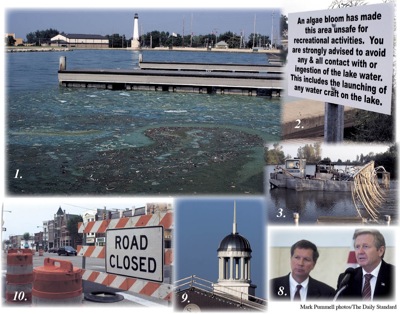Friday, December 31st, 2010
Lake alum test failed
Report recommends 2nd alum study in spring
By Nancy Allen
GRAND LAKE - Officials are recommending another alum study be conducted on Grand Lake this spring after results released Thursday showed the first test failed.
The $250,000 Ohio EPA-funded pilot test was done to determine if alum could reduce the lake's toxic blue-green algae by taking away phosphorous, the algae's main food source. Alum binds phosphorous into a floc and causes it to drop to the lake's bottom.
The test results and recommendations were compiled by Tetra Tech, the environmental consulting firm hired by the state to design the test and analyze the outcome.
Test sites at Harmon's Landing, the West Bank boat launch and Otterbein Retirement Community were cordoned off with curtains and dosed with alum in September. The sites were monitored biweekly for total phosphorous and chlorophyll counts. Multiple untreated control sites also were monitored, Tetra Tech's report says.
EPA officials are not commenting on "what the results mean" until technical staff from the EPA and Ohio Department of Natural Resources meet Monday to discuss it, Ohio EPA spokeswoman Dina Pierce said Thursday.
"We need time to digest it and talk about it and what our next steps will be," Pierce said. "Another factor will be we have a new administration coming in after Jan. 10, and they will be the new decision makers."
Gov.-elect John Kasich has appointed Scott Nally as new director of the Ohio EPA and David Mustine as new director of the ODNR. Nally, an Indiana native, currently is assistant commissioner of Indiana's Department of Environmental Management, and Mustine is a former American Electric Power executive.
The report's summary says alum initially cleared the water at all three test sites, but over the following two months total phosphorous and chlorophyll were only reduced 50 to 60 percent at the Harmon's and Otterbein sites. No reductions were observed at the West Bank site.
The report blames the poor results on the high concentration of blue-green algae, which comprised the binding capacity of the alum, and the likely encroachment of outside water into the treatment areas.
The report says the lack of effectiveness at the West Bank site was "unexpected." Extremely high concentrations of algae, ineffective barrier curtains that allowed untreated water into the site and an uneven distribution of alum caused by extremely windy conditions may explain the results, the report says.
The failure of the alum is likely because the treatment was done during a period of high algae conditions, the report says. Algae blooms are the most severe during hot summer months.
Spring is the optimal time to treat because blue-green algae concentrations are low and the alum floc can still retain sufficient binding capacity. Based on conditions this year, April and May would be the best time to reapply alum because the algae blooms did not begin to increase until June, the report says.
Another recommendation in the report is pretreating the test sites with hydrogen peroxide to effectively tie up the sediment already on the bottom of the lake.
The state has said if alum is effective in reducing blue-green algae, the state would find the estimated $10 million to do a whole-lake treatment. Tetra Tech recommends that treatment be designed based on results of a spring test.
A whole-lake treatment would be used as a short-term solution to reduce phosphorous already in the lake. During the temporary fix, the state plans to make changes in land management practices in the 98,000-acre Grand Lake watershed to reduce the amount of phosphorous running off land and getting into the lake.
Most of the phosphorous comes from farmland, which comprises more than 80 percent of acreage in the watershed. Watershed farmers already are signing up for government funds to install best management practices to reduce runoff and will have to start following new manure management rules beginning in January.
A second short-term solution being tested involves adding silica (sand) to the lake to feed the lake's good, diatom algae so it overtakes the blue-green algae. That 60-day test near the Celina Rotary lighthouse wrapped up in November. This $25,000 pilot study was funded by the Ohio Department of Agriculture with results expected early in the new year.
For the second consecutive summer the lake suffered from toxic, blue-green algae blooms that practically shut down the 13,500-acre lake.
By late July, the Ohio Department of Natural Resources (ODNR) had posted signs around the lake telling people not to swim, boat or eat fish from it because of unsafe toxin levels. The advisory was lifted in late October after toxin levels dropped to safe levels.


